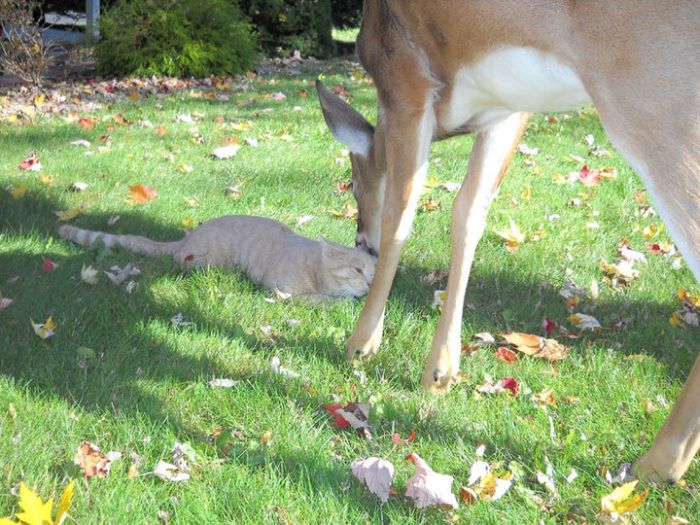Cat And A Little Deer
|
The Eurasian Continent (including the Indian Subcontinent) boasts the most species of deer in the world, with most species being found in Asia. Europe, in comparison, has lower diversity in plant and animal species. However, many national parks and protected reserves in Europe do have populations of Red Deer, Roe Deer, and Fallow Deer. These species have long been associated with the continent of Europe, but also inhabit Asia Minor, the Caucasus Mountains, and Northwestern Iran. "European" Fallow Deer historically lived over much of Europe during the Ice Ages, but afterwards became restricted primarily to the Anatolian Peninsula, in present-day Turkey. Present-day Fallow deer populations in Europe are a result of historic man-made introductions of this species first to the Mediterranean regions of Europe, then eventually to the rest of Europe. They were initially park animals that later escaped and reestablished themselves in the wild. Historically, Europe's deer species shared their deciduous forest habitat with other herbivores such as the extinct tarpan (forest horse), extinct aurochs (forest ox), and the endangered wisent (European bison). Good places to see deer in Europe include the Scottish Highlands, the Austrian Alps, and the wetlands between Austria, Hungary, and Czech Republic. Some fine National Parks include Doñana National Park in Spain, the Veluwe in the Netherlands, the Ardennes in Belgium, and Białowieża National Park of Poland. Spain, Eastern Europe, and the Caucasus Mountains still have virgin forest areas that are not only home to sizable deer populations but also for other animals that were once abundant such as the wisent, Eurasian Lynx, Spanish lynx, wolves, and Brown Bears.
The highest concentration of large deer species in temperate Asia occurs in the mixed deciduous forests, mountain coniferous forests, and taiga bordering North Korea, Manchuria (Northeastern China), and the Ussuri Region (Russia). These are among some of the richest deciduous and coniferous forests in the world where one can find Siberian Roe Deer, Sika Deer, Elk, and Moose. Asian Caribou occupy the northern fringes of this region along the Sino-Russian border.
Deer such as the Sika Deer, Thorold's deer, Central Asian Red Deer, and Elk have historically been farmed for their antlers by Han Chinese, Turkic peoples, Tungusic peoples, Mongolians, and Koreans. Like the Sami people of Finland and Scandinavia, the Tungusic peoples, Mongolians, and Turkic peoples of Southern Siberia, Northern Mongolia, and the Ussuri Region have also taken to raising semi-domesticated herds of Asian Caribou.
The highest concentration of large deer species in the tropics occurs in Southern Asia in Northern India's Indo-Gangetic Plain Region and Nepal's Terai Region. These fertile plains consist of tropical seasonal moist deciduous, dry deciduous forests, and both dry and wet savannas that are home to Chital, Hog Deer, Barasingha, Indian Sambar, and Indian Muntjac. Grazing species such as the endangered Barasingha and very common Chital are gregarious and live in large herds. Indian Sambar can be gregarious but are usually solitary or live in smaller herds. Hog Deer are solitary and have lower densities than Indian Muntjac. Deer can be seen in several national parks in India, Nepal, and Sri Lanka of which Kanha National Park, Dudhwa National Park, and Chitwan National Park are most famous. Sri Lanka's Wilpattu National Park and Yala National Park have large herds of Indian Sambar and Chital. The Indian sambar are more gregarious in Sri Lanka than other parts of their range and tend to form larger herds than elsewhere.
|
|









